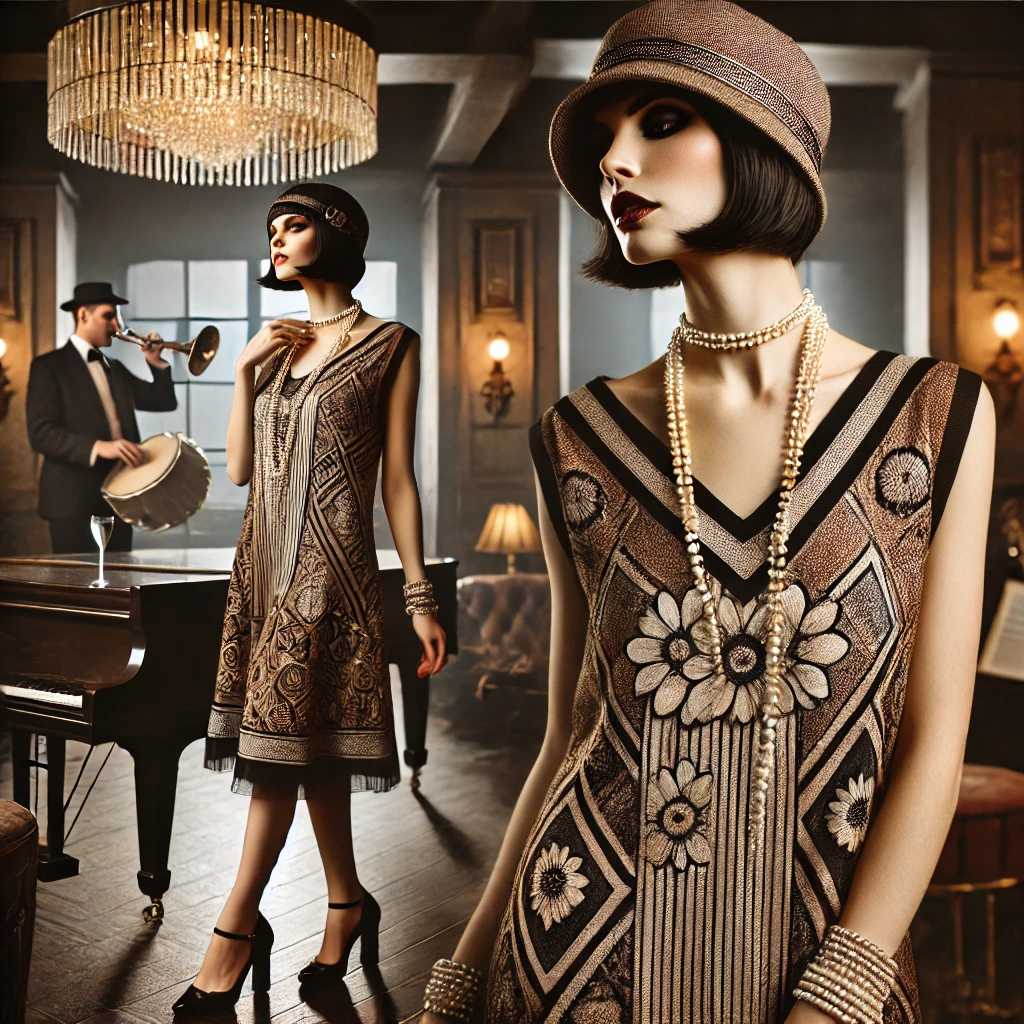Vintage fashion has always been a reflection of the social, cultural, and economic realities of its time. From luxurious gowns worn by the elite to practical workwear crafted for the laboring class, the evolution of women’s clothing offers a fascinating glimpse into the past. This article explores the trends that defined women’s fashion from the 1910s to the 2000s, shedding light on how vintage fashion evolved to accommodate the needs and aspirations of both the affluent and the working class.
The Early 20th Century (1910s-1930s): Elegance and Resilience
The Edwardian Era (1910s)
The 1910s marked the end of the Edwardian era, characterized by opulence and elegance. Women’s clothing featured high collars, lace embellishments, and long skirts that exuded sophistication. Corsets remained a staple, shaping the hourglass figure idealized at the time. However, World War I brought significant changes.
- Impact of World War I: The war necessitated practicality in women’s attire. Corsets began to fall out of favor, replaced by looser silhouettes and simpler designs. Women’s roles expanded into the workforce, influencing the adoption of tailored suits and shorter hemlines for mobility and convenience.
- Influence of Art Nouveau: Flowing lines and floral patterns inspired by the Art Nouveau movement were popular, blending artistry with functionality.
The Roaring Twenties (1920s)
The 1920s ushered in a dramatic shift toward freedom and rebellion in fashion.

- Flapper Style: Shorter hemlines, dropped waistlines, and loose-fitting dresses defined the flapper look. Beaded embellishments and fringe detailing added flair, while cloche hats became an iconic accessory.
- Androgyny: Women’s fashion took on a more androgynous style, with bobbed haircuts and minimalistic designs symbolizing liberation from traditional gender norms.
- Influence of Jazz Culture: The vibrancy of jazz music and dance influenced eveningwear, with fabrics like silk and chiffon dominating the scene.
The Great Depression (1930s)
The economic downturn of the 1930s brought a return to more conservative and resourceful fashion.
- Practicality and Elegance: While budgets were tight, women’s clothing still emphasized elegance through bias-cut gowns and tailored suits. Homemade clothing and repurposed fabrics became common.
- Hollywood Glamour: Movies offered an escape from harsh realities, inspiring women to emulate the glamorous styles of screen icons like Greta Garbo and Jean Harlow.
Mid-Century Style (1930s-1960s): Glamour and Innovation
World War II and the 1940s
Fashion in the 1940s reflected the constraints of wartime.
- Rationing and Utility: Government-imposed fabric rationing led to shorter skirts, narrower silhouettes, and utilitarian designs. The “Victory Suit”—a tailored jacket and skirt combo—became a staple.
- Rosie the Riveter Influence: Workwear like overalls and sturdy shoes gained prominence as women joined the workforce in unprecedented numbers.
- Post-War Revival: The end of the war saw a return to feminine styles, with cinched waists and full skirts symbolizing prosperity and optimism.
The New Look of the 1950s
Christian Dior’s “New Look” revolutionized post-war fashion.
- Hourglass Silhouettes: Full skirts paired with fitted bodices created a dramatic hourglass shape. Poodle skirts and swing dresses were popular among younger women.
- Luxurious Fabrics: Silk, tulle, and satin were widely used, emphasizing elegance and femininity.
- Casual Wear: Denim jeans and capri pants became acceptable for casual outings, reflecting a growing emphasis on comfort.
The Revolutionary 1960s-1990s: Freedom and Experimentation
Swinging Sixties (1960s)
The 1960s broke away from traditional fashion norms, embracing bold experimentation.
- Mini Skirts and Mod Style: Designers like Mary Quant popularized the mini skirt, while mod fashion featured geometric patterns, vibrant colors, and A-line silhouettes.
- Youth Culture Influence: The rise of youth culture and countercultural movements made casual, expressive styles mainstream. Shift dresses, go-go boots, and psychedelic prints were hallmarks of the era.
- Haute Couture: High-end fashion houses like Yves Saint Laurent introduced iconic pieces, including the Mondrian dress, blending art and fashion.
The 1970s: Bohemian Rhapsody
The 1970s celebrated individuality and freedom, heavily influenced by the hippie movement.
- Bohemian Styles: Flowy maxi dresses, peasant blouses, and bell-bottom pants reflected a laid-back, bohemian aesthetic.
- Earth Tones and Natural Fabrics: A focus on sustainability and natural living inspired the use of organic fabrics and earthy color palettes.
- Disco Fever: The late ’70s brought glitzy disco fashion, with metallic fabrics, jumpsuits, and platform shoes dominating dance floors.
The Power Dressing of the 1980s
The 1980s embraced bold, statement-making fashion.
- Power Suits: Shoulder pads, structured blazers, and pencil skirts symbolized women’s growing presence in the corporate world.
- Bright Colors and Patterns: Neon hues, animal prints, and oversized accessories added drama to everyday wear.
- Pop Culture Influence: Icons like Madonna and Princess Diana set trends with their distinctive styles, from edgy punk looks to elegant evening gowns.
Contemporary Nostalgia (1990s-2000s): Minimalism and Revival
The 1990s: Grunge and Minimalism
The 1990s saw a mix of rebellion and restraint in fashion.
- Grunge Aesthetic: Plaid flannel shirts, ripped jeans, and combat boots defined the grunge look, popularized by bands like Nirvana.
- Minimalism: Designers like Calvin Klein championed clean lines, neutral tones, and simple silhouettes, reflecting a “less is more” philosophy.
- Retro Revival: Vintage-inspired styles, including ‘60s shift dresses and ‘70s flared jeans, experienced a resurgence.
The Early 2000s: Eclecticism and Y2K Aesthetics
The turn of the millennium brought an eclectic mix of styles.
- Y2K Fashion: Metallic fabrics, futuristic designs, and low-rise jeans captured the optimism and technological fascination of the era.
- Celebrity Influence: Pop stars like Britney Spears and Jennifer Lopez popularized crop tops, bedazzled accessories, and bold makeup.
- Globalization: Cultural influences from around the world enriched fashion, leading to the fusion of traditional and modern styles.
Conclusion: The Timeless Allure of Vintage Fashion
Vintage fashion continues to captivate modern audiences with its blend of history, artistry, and individuality. From the refined elegance of the 1910s to the eclecticism of the 2000s, each era offers a unique narrative that resonates with contemporary trends. Whether through high-end vintage collections or thrifted treasures, the legacy of vintage fashion lives on, bridging the past and the present with timeless style.
